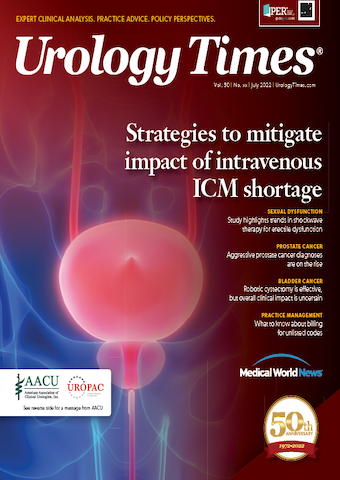Publication
Article
Urology Times Journal
Aggressive prostate cancer diagnoses on the rise
Author(s):
The downgrade of PSA screening over the past 15 years has reduced the overdiagnosis and overtreatment of low-grade prostate cancer; however, there has been a simultaneous increase in the rate of metastatic cancer at diagnosis, according to a study published in the Journal of the National Cancer Institute.1,2
Jim Hu, MD, MPH

“To our knowledge, this is the first study to demonstrate nationally that low-grade prostate cancer is no longer the most commonly diagnosed type of prostate cancer,” senior author Jim Hu, MD, MPH, the Ronald P. Lynch Professor of Urologic Oncology at Weill Cornell Medicine and director of the LeFrak Center for Robotic Surgery at NewYork-Presbyterian/Weill Cornell Medical Center, stated in a news release. “One of the weaknesses of PSA/prostate cancer screening was that it led to over-detection of indolent cancers that would not harm men, subjecting them to anxiety and future testing.”
In 2012, after concluding that the benefit of PSA screening did not outweigh risks of overdiagnosis and overtreatment of low-grade prostate cancer, the US Preventive Services Task Force (USPSTF) issued a grade D recommendation against the use of PSA screening in the general US population, regardless of age. The current USPSTF PSA screening policy is slightly changed, with a grade C recommendation for men aged 55 to 69 years, meaning in this population, an individual decision on screening should be made based on a physician-clinician discussion of the potential benefits and risks. For men aged ≥70 years, the USPSTF recommends against any PSA-based screening (grade D recommendation). The panel also does not recommend screening for men aged <55 years.
With their study, Hu et al sought to determine the overall impact of the screening downgrade on Gleason Grade Group (GGG) at diagnosis and radical prostatectomy (RP) pathology. Using the SEER Registry Database, the researchers identified 438,432 men with newly diagnosed prostate cancer in the period from 2010 to 2018.
During this 8-year period, the rate of metastases at diagnosis increased from 3.0% to 5.2% (P <.001). The investigators linked this rise to the decrease in PSA screening, and suggested risk-stratified screening using MRI or biomarkers as a potential solution to maintaining the progress in reducing overdiagnosis/overtreatment while not missing these aggressive cancers.
The upside of what Hu et al found was that the incidence of low-grade PC (GG1) per 100,000 cases decreased from 52 to 26 cases (P <.001). As a proportion of all prostate cancer cases, the incidence of GG1 decreased from 47% to 32% (P <.001). At RP pathology, the incidence of GG1 decreased from 32% to 10% (P <.001).
“The fact that only 10% of radical prostatectomy specimens demonstrate low-grade prostate cancer indicates that even when low grade cancer is diagnosed, it is being treated much less frequently,” Hu stated. “This demonstrates that there has been acceptance of active surveillance, also known as monitoring with curative intent, among doctors and patients nationally.”
Leonardo Borregales, MD

“It is encouraging to see that urologists in the United States have moved away from overutilization of radical therapies for the management of low-risk prostate cancer,” first author Leonardo Borregales, MD, a urologic oncology fellow at Weill Cornell Urology added in the news release.
References
1. Less Prostate Cancer Screening Reduces Overdiagnosis but May Miss Aggressive Cases. Published online April 22, 2022. Accessed April 22, 2022. https://bit.ly/3w1iSnx.
2. Borregales LD, DeMeo G, Gu X, et al. Grade migration of prostate cancer in the United States during the last decade [published online March 28, 2022]. J Natl Cancer Inst. doi: 10.1093/jnci/djac066.

Newsletter
Stay current with the latest urology news and practice-changing insights — sign up now for the essential updates every urologist needs.


























